The Samsung Galaxy S6 and S6 edge Review
by Joshua Ho on April 17, 2015 9:00 AM EST- Posted in
- Smartphones
- Samsung
- Mobile
- Galaxy S6
- Galaxy S6 Edge
Display
As we briefly discussed in our look at the specifications, the Galaxy S6 line introduces a newer generation of AMOLED displays, which is said to increase maximum luminance to 600 nits. Samsung claims that this was achieved with the use of new materials, which is likely necessary in order to sustain power efficiency improvements. It doesn't seem that AMOLED is uniquely suited to high resolution, but rather that Samsung Display Corp. is managing to dramatically improve how they make AMOLED displays with every year that offset power consumption increases from higher resolution displays.
To find out how Samsung did, we use SpectraCal's CalMAN 5 Ultimate, in addition to X-Rite's i1Pro2 Basic to characterize displays as accurately as possible.
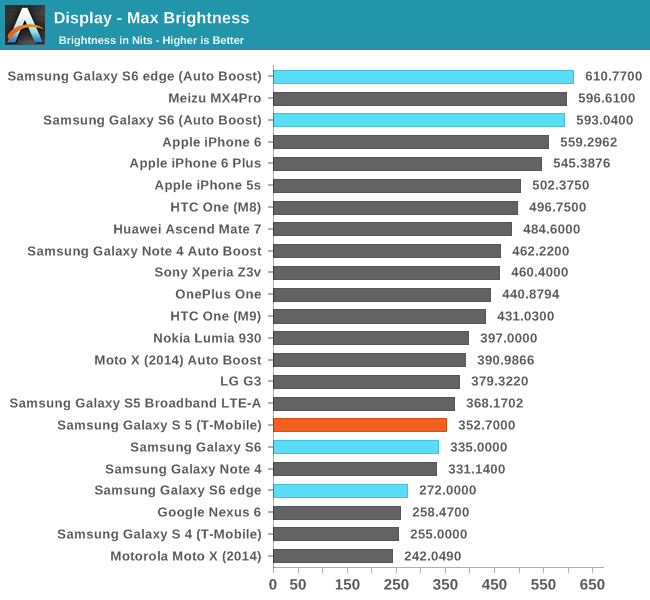
From the results Samsung's claims of a 600 nit display are valid in this case, which is a 100% APL white display. It's important to note that achieving this requires the use of auto-brightness, and that manual brightness is limited to a much lower brightness to reduce power usage, here the S6 sees similar maximum brightness as the S5. The S6 edge disappointingly only achieves 272 nits in this mode, a rather low value. I saw color balance shift dramatically in auto-boost mode, which suggests that this operating mode is likely less efficient than manual brightness. As an explanation, we've seen that colors are controlled in AMOLED by voltage while brightness is controlled by PWM (pulse width modulation). As with most recent AMOLED displays, there's no DC bias to the pixels so the contrast really is infinite instead of just a very large number when displaying black.
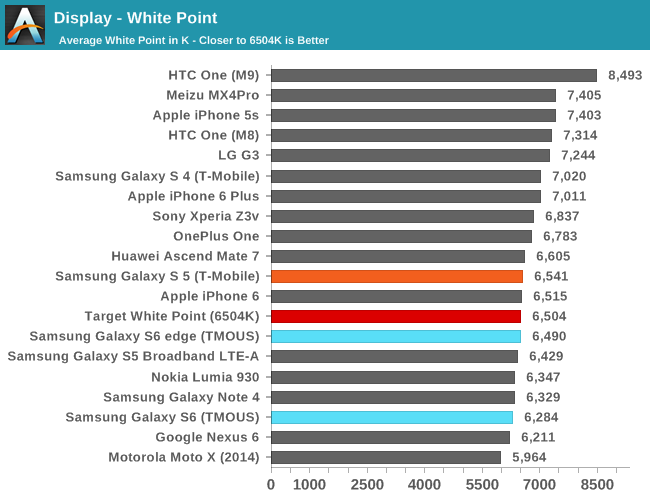

Moving on to grayscale, we can see that Samsung has done a pretty good job of controlling the white point and gamma across the saturation sweep, even if green is slightly dominant in both displays. We can also see that there is variation across displays as the S6 edge is closer to neutral while the S6 sample tends a bit warmer.
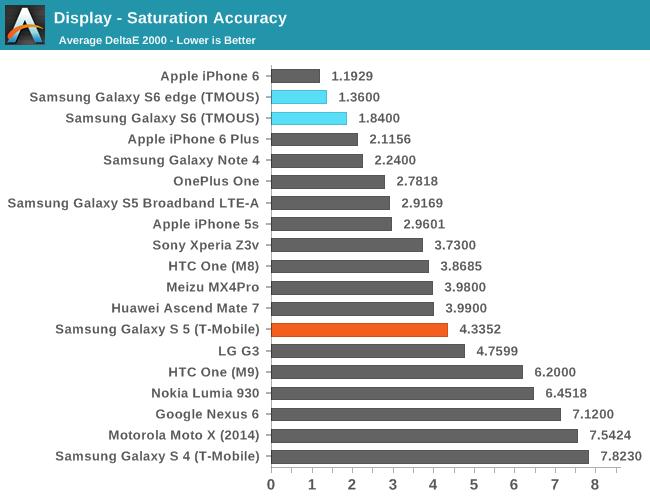
In the saturation sweep, both displays do an incredible job. I really don't have anything else to say here, because there's really no way to improve on the level of calibration Samsung has done on this display. Unless Samsung calibrates every single display in production, which is wildly impractical and effectively impossible to do, this is as good as it gets for a mass-produced device. Improving past this point will also be incredibly difficult to perceive, which means there's no real reason to go any further.
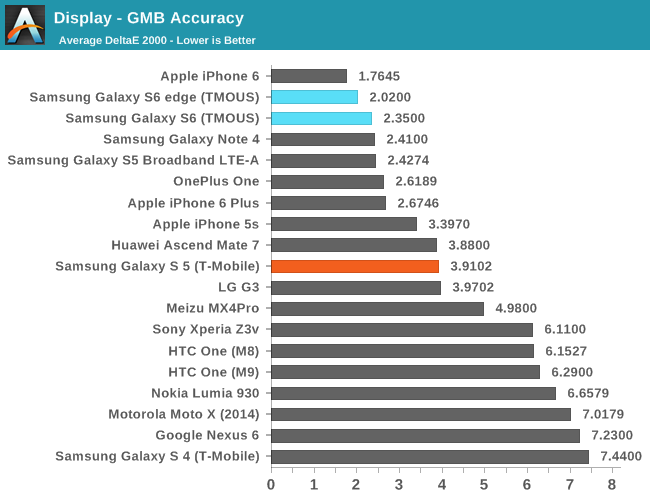
In the Gretag MacBeth ColorChecker, we can get an idea for overall color accuracy, which paints a picture similar to the saturation test. The only real problem I've noticed with these displays are the viewing angles, which can produce color shifting when the display is tilted. This is a bit of an issue on the edge variant as I can see that the edges of the display appear somewhat green when viewed head on, but otherwise there are no real issues to be seen here.
Overall, from a color standpoint it’s looking like Samsung has made one of the best displays available on the market today. Color accuracy is at the point where it’s pretty safe to say that the calibration doesn’t have clear color errors, and the peak brightness of the display is incredibly high. The 1440p resolution helps to compensate for the PenTile subpixel layout so in practice it’s effectively impossible to make out any pixels or the subpixel pattern. The contrast remains infinite as with most modern AMOLED displays, and overall it’s really hard to find any issue with the Galaxy S6’s display at first.
However while the S6 edge seems to be without any issues, the S6 does have some odd display issues that can be seen in direct sunlight as seen in the photo above. To be clear about this the photo above is a simple white screen, which should make the image completely homogeneous but instead there are two visible vertical lines and another jagged horizontal line that appear across the display. Inspection under a light microscope doesn’t really reveal what’s causing this, but the defect is quite visible in practice as seen in the photo above. I suspect that defects are rare, and in any condition other than direct sunlight I can’t see this visual problem.
While trying to see what this kind of defect looked like under a microscope, I also went ahead and took some photos of the subpixel pattern. As far as I can tell, it looks like the green subpixels have a bit more variance than what we’re used to as they tend towards oblong shapes rather than circles, which is likely due to the much tighter pixel density. It seems that this variance may cause some color shifting in certain units, which seems to remain a potential problem with Samsung's AMOLED displays. The pixel fill factor still remains surprisingly low when compared to LCDs, which usually have much higher active area. Due to the subpixel arrangement and some other differences in the display design, color shifting also remains higher than one would expect from LCD displays that are found in phones like the iPhone 6.
The final test that I managed to run on the Galaxy S6 is the brightness vs APL test, which shows the advantage of AMOLED’s emissive nature as it can dynamically increase brightness if the entire display isn’t showing a white screen. As a result, this means that in low APL scenarios like dark movie scenes and app themes it’s possible to see a maximum brightness closer to 700 nits or higher. However, in practice the display’s practical brightness is closer to 600 nits.
Overall, the display is still one of the best on the market, but I would be a bit concerned about fill factor for VR applications as that was a problem on the Note 4. Issues like purple smearing have been resolved, but there are still some problems with the display such as color shifting with changes to viewing angles and some variability in display quality from unit to unit. With this generation I suspect Samsung is either meeting or exceeding the best LCDs in quality, and with the next generation of AMOLED it’s likely that high end smartphones will have to migrate to AMOLED to remain competitive.



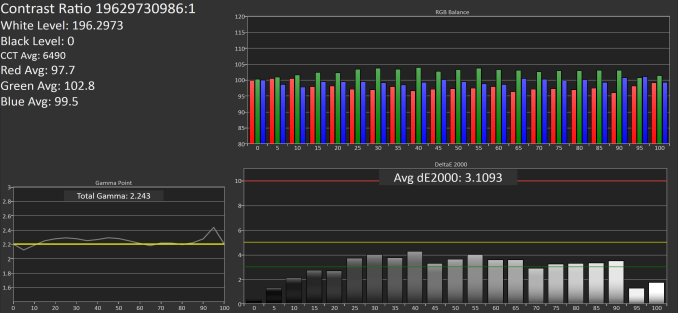
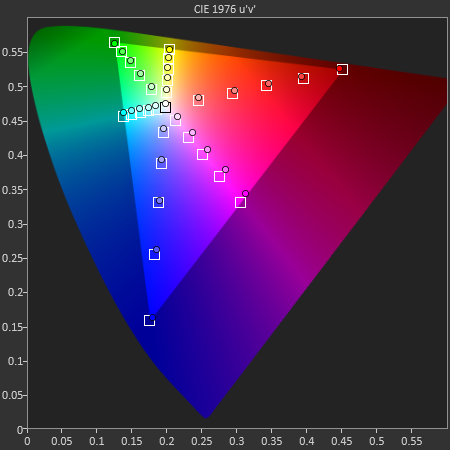
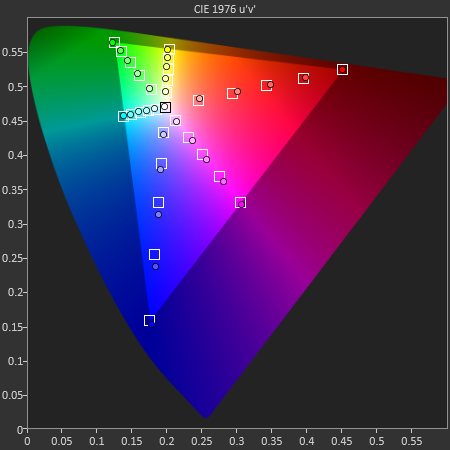
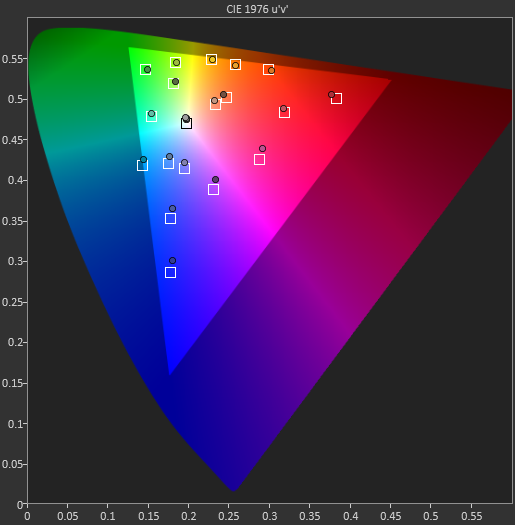

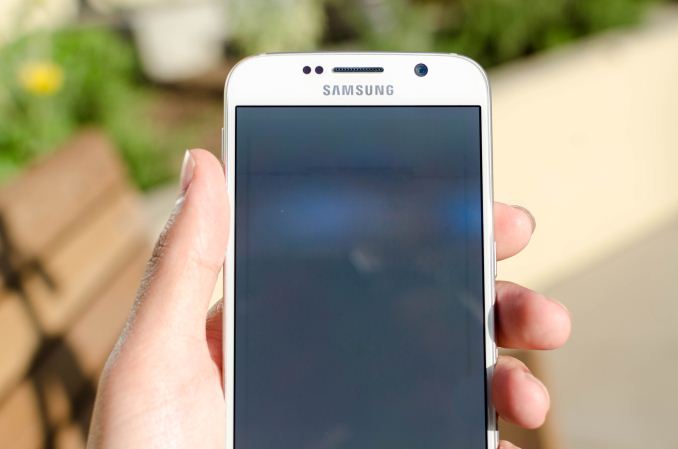
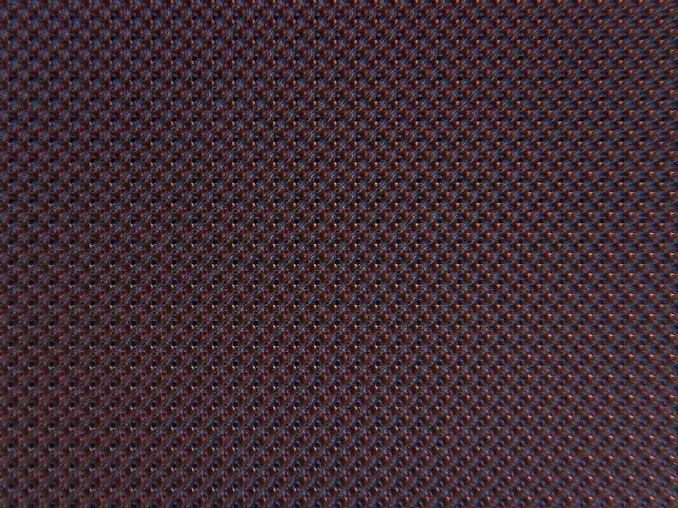
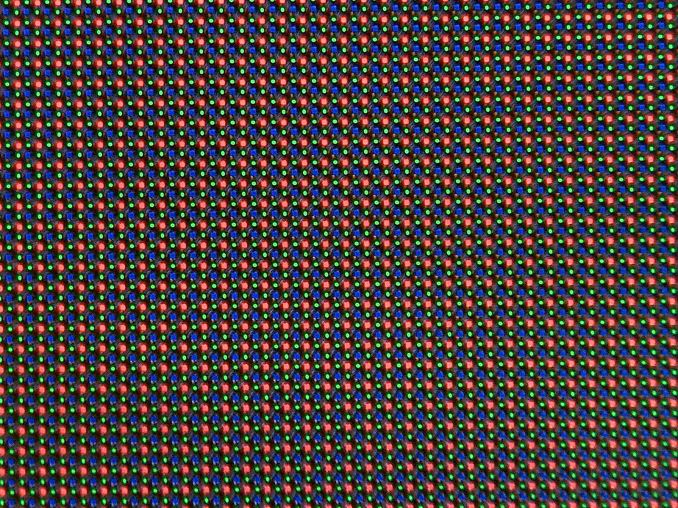
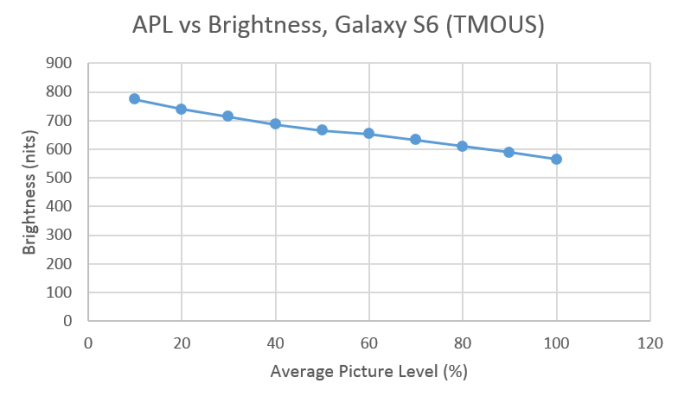








306 Comments
View All Comments
JoshHo - Friday, April 17, 2015 - link
Something similar to the APx582 would be necessary to test 3.5mm output accurately, and a good SPL meter would help with speaker quality although I'm not sure results for the latter would be comparable between editors.IsthatyouBevis - Friday, April 17, 2015 - link
Wow, that camera comparison is really poorly done. Trying to compare what you seem to think are the 2 best cameras (iPhone 6+ and S6) was extremely difficult. Why do you present the galleries in such a way as it is impossible to determine which picture to click to see which phone and why can't we see them clearly in the same page, instead of the click fest you force us to go through? Surely there is a better way to demonstrate this?johnnohj - Friday, April 17, 2015 - link
1. Were these photos taken with Auto-HDR enabled? If I am not mistaken, both the iPhone and S6 ship with Auto-HDR turned on by default. Those impressive low-light photos Samsung showed at the unveiling were taken with Auto-HDR enabled.2. Can immersive mode (full-screen) be disabled on Samsung apps like Calculator and S-Planner?
3. Were there any problems with RAM management like in this video https://youtu.be/hUw9PUlFUF0?t=1m32s where the S6 keeps killing apps in the background? It could explain the poor battery life some people are experiencing as apps would have to be killed and reloaded all day.
4. Can heads-up notifications be disabled?
5. I wish there was a way to test standby battery usage. It is something android phones have always been poor at compared to iPhones. How about a test where the x most popular apps (like Facebook, Gmail, WhatsApp, Instagram, Twitter with the same accounts, sync enabled) are installed to multiple test devices on the same wifi network and the battery usage is measured after x hours?
6. Why does Samsung still include the Quick Connect and S-Finder buttons in the notification slider? It's so annoying, and there is no way to disable them without root (except on a few US carrier versions).
Hrel - Friday, April 17, 2015 - link
No sd card is pretty bad, but being Samsung is worse.khujin - Friday, April 17, 2015 - link
I just tested GS6 edge 64GB and Androbench4.0 result is 320MB/s(seq. read), 140MB/s(seq. write) with default setting. And another website GS6 performance review it the same as mine. please check the UFS test.JoshHo - Friday, April 17, 2015 - link
The default sequential test does 32MB sequential reads which is wildly unrealistic at best. As shown in the storage performance section we test using 256KB reads and writes for sequential performance.heartinpiece - Saturday, April 18, 2015 - link
Nice review Joshua! I don't see any Ipad Air 2 performances in the performance charts (although they are constantly referenced...) could you check on the graphs?Peichen - Saturday, April 18, 2015 - link
Seems like there are only 2 company making real flagship phones now: Apple and Samsung. To achieve this status, buying off-the-shelf parts are no longer good enough. You need to custom order parts and optimize the software specifically for the parts. From SoC, memory, screen to camera, everything is custom ordered to achieve the best quality. Off-the-shelf phones like M9 and Nexus 6 are relegated to good $500ish phone status.On the other hand, it is sad to see Samsung abandon all its believes and completely adapted Apple design and philosophy. Nano-SIM, downward speaker, simplified camera UI, fingerprint magnet back, home-button scanner and the abandonment of colorful UI and screen tone. Samsung users always love the punchy screen color. What are they going to say now the school is color corrected like iPhone display?
Peichen - Saturday, April 18, 2015 - link
screen*Impulses - Saturday, April 18, 2015 - link
Maybe, I think LG or Sony could still step up to the plate... Sony's got a whole bunch of outside issues threatening the future of it's phone division tho, and probably their budget. Which is a shame because they made the only SMALL flagship phone last year in the Z3c.The bigger issue at play might be that a good chunk of the market is now complacent with their $500 or less also-rans, and another sizeable chunk is just buying outgoing models instead of the current hotness. Otherwise the SGS5 should've sold even better than the 4, and it had every right to based on hardware alone.
I'm part of that segment tbh, huge Android fan, initially went thru three successive HTC phones year after year... Not really feeling that upgrade bug anymore, at all. I'd like better battery life than what my N5 offers, and/or water resistance, can live without either for now.
My phone isn't my main camera so I'm an exception there but I don't think the average buyer even realizes what makes for a better camera or reads AT to find out.